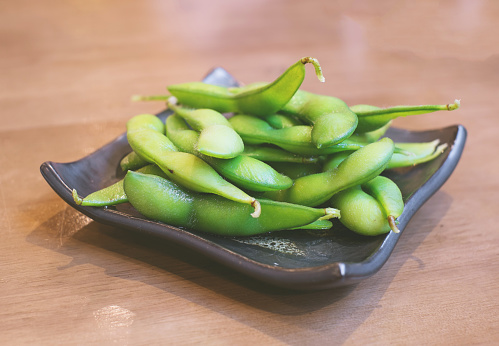Buffets, food ads on TV, recipes on Pinterest, ice cream calling to you from the freezer—modern life is a minefield of temptations that can lead to overeating.
Fortunately, there are also dozens of scientifically vetted ways to make your way safely through without packing on pounds. Keep this list nearby and consult it when you think you’re about to overindulge.
1. Fill your belly.
But not just with any old thing. Studies have shown that foods high in fiber can help curb the urge to overeat. One reason: These foods take so long to eat—you have to chew fibrous foods much longer than a bar of chocolate to break them into digestible pieces. Another: Like sponges, they expand in your stomach, making you feel full. One study, published in the journal Nutrition Reviews, found that by adding 14 grams of fiber to your diet, you can cut your calorie intake by 10 percent. Study participants who did this lost four pounds in fewer than four months—without even trying.
2. Eat slowly.
You’ve heard it before, and a study from the Texas Christian University proves it: Taking your time to eat and chew can result in greater feelings of fullness before you even finish your meal. In this study, people were asked to take small bites, chew thoroughly, pause and put their utensils down between bites. Those who did ate 58-88 fewer calories per meal than they did when they ate more quickly. One behavior that slow eating triggered interested the researchers: When they ate at a leisurely pace, the participants drank more water, which may have also contributed to curbing their appetite.
3. Master chopsticks.
Chopsticks help you eat slower, say researchers at Cornell University’s Food & Brand Lab. This is especially important if you’re eating at a Chinese restaurant buffet where the temptation to not only load your plate but to go back for more is nearly irresistible. The delay can help you notice the feelings of fullness that don’t usually kick in till about 20 minutes after you’ve started eating.
4. Cap off your meal with a low-fat cappuccino.
A 2014 study published in the International Journal of Obesity reported that people who had a roughly 8-16-ounce “foamy drink” after meals weren’t tempted to eat more. Specifically, they had no “appetite for a snack,” the researchers said. Ask for extra foam! Just be sure to lay off the sugary extras like whipped cream and syrup.
5. Keep protein on the plate.
Protein not only curbs your appetite, it can help change your body composition (in a good way), according to a review study in the Annual Review of Nutrition. For one thing, the researchers point out, people feel more satisfied on smaller amounts of protein than they do when eating carbohydrates. Your body also expends more energy burning and storing protein calories than it does with carbs. Eating protein also helps you maintain lean muscle while losing weight. Those muscles also help burn more calories. Many protein sources come with too much fat, so choose lean cuts of meat and look to non-meat sources, such as nuts and other foods with monounsaturated fats.
6. Choose beans.
They’re not only chock full of fiber, beans have satisfying protein that, in one study published in the journal Obesity, made participants feel 31 percent fuller than those who didn’t have beans. The study looked at beans and other legumes, such as chickpeas, lentils and peas. Participants consumed only between three-quarters of a cup and one cup a day.
7. Fatten up.
All fats are not created equal, though they’re equally satisfying. A study in Nutrition Journal found that people who consumed half an avocado at lunch time were 40 percent less likely to want to eat for several hours afterwards. Avocados, like nuts and olive oil, contain heart-healthy monounsaturated fats.
8. Buy smaller plates.
Larger plates both in restaurants and at home have changed how we look at portion sizes, says Brian Wansink, PhD, a Cornell University researcher and author of Mindless Eating: Why We Eat More Than We Think. In his studies of eating behavior, people feel just as full when they clean a 9.5 inch plate as they do when they finish a meal on a 12-inch plate and yet they eat about 22 percent less. It’s a mind trick that you can use to prevent mindless overeating.
9. Start with soup or salad.
Multiple studies by Penn State researcher Barbara Rolls, PhD, author of Volumetrics: Feel Full on Fewer Calories, find that eating foods with a high water content—soups, salads, dishes with added vegetables, smoothies—can help you eat less. In several of her studies, people who “ate” their water ate less at the meal and were still feeling satisfied hours later. Top your whole wheat pasta with a sauce made with a rainbow of veggies and add tomatoes and lettuce to all your sandwiches.
10. Do something besides eating that makes you feel good.
The fact is, just imagining something pleasant as vividly as you can may help you beat food cravings that can lead you to overeat, says a 2011 study by researchers at McGill University in Canada. They found that even when they tempted participants with images of food—proven to make us hungry, something all food retailers know—those who thought about their favorite activities were able to fight the feeling. Think you’re going to overdo? Grab your needlework, re-read your favorite novel, putter in the garden, strum your guitar—whatever makes you feel great. Failing that, spend some time imagining some of your favorite things. Any of these options should help you to stop eating so much.
The post 10 Simple Ways to Stop Eating So Much appeared first on The Leaf.
from The Leaf https://ift.tt/2yik5w4



No comments:
Post a Comment